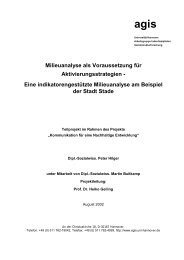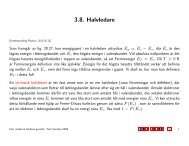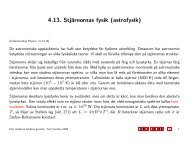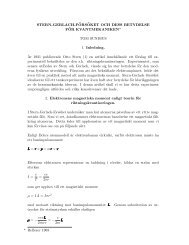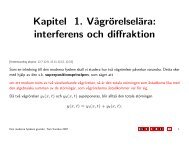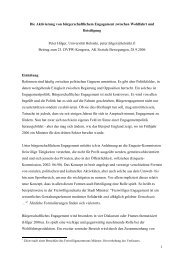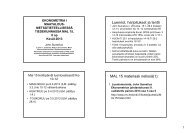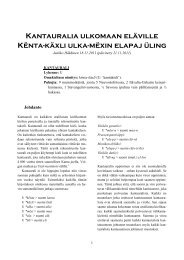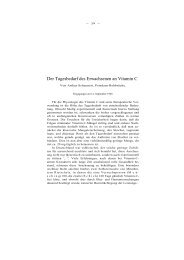Cochrane Handbook for Systematic Reviews of Interventions 4.2.6
Cochrane Handbook for Systematic Reviews of Interventions 4.2.6
Cochrane Handbook for Systematic Reviews of Interventions 4.2.6
You also want an ePaper? Increase the reach of your titles
YUMPU automatically turns print PDFs into web optimized ePapers that Google loves.
<strong>Cochrane</strong><br />
<strong>Handbook</strong> <strong>for</strong><br />
<strong>Systematic</strong><br />
<strong>Reviews</strong> <strong>of</strong><br />
<strong>Interventions</strong><br />
<strong>4.2.6</strong><br />
Updated September 2006<br />
© The <strong>Cochrane</strong> Collaboration, 2006.
About the handbook<br />
Editors<br />
Julian PT Higgins and Sally Green.<br />
How to cite this version <strong>of</strong> the <strong>Handbook</strong><br />
Higgins JPT, Green S, editors. <strong>Cochrane</strong> <strong>Handbook</strong> <strong>for</strong> <strong>Systematic</strong> <strong>Reviews</strong> <strong>of</strong> <strong>Interventions</strong><br />
<strong>4.2.6</strong> [updated September 2006]. In: The <strong>Cochrane</strong> Library, Issue 4, 2006. Chichester, UK:<br />
John Wiley & Sons, Ltd.<br />
or<br />
Higgins JPT, Green S, editors. <strong>Cochrane</strong> <strong>Handbook</strong> <strong>for</strong> <strong>Systematic</strong> <strong>Reviews</strong> <strong>of</strong> <strong>Interventions</strong><br />
<strong>4.2.6</strong> [updated September 2006]. http://www.cochrane.org/resources/handbook/hbook.htm<br />
(accessed 6th October 2006).<br />
When referring to a specific section or subsection refer to it by the title and section number,<br />
NOT page numbers. For example:<br />
Higgins JPT, Green S, editors. Formulating the problem. <strong>Cochrane</strong> <strong>Handbook</strong> <strong>for</strong> <strong>Systematic</strong><br />
<strong>Reviews</strong> <strong>of</strong> <strong>Interventions</strong> <strong>4.2.6</strong> [updated September 2006]; Section 4. In: The <strong>Cochrane</strong><br />
Library, Issue 4, 2006. Chichester, UK: John Wiley & Sons, Ltd.<br />
or<br />
Higgins JPT, Green S, editors. Formulating the problem. <strong>Cochrane</strong> <strong>Handbook</strong> <strong>for</strong> <strong>Systematic</strong><br />
<strong>Reviews</strong> <strong>of</strong> <strong>Interventions</strong> <strong>4.2.6</strong> [updated September 2006]; Section 4.<br />
http://www.cochrane.org/resources/handbook/hbook.htm (accessed 6th October 2006).<br />
When referring to a section that has section editors listed, use:<br />
Deeks JJ, Higgins, JPT, Altman DG, editors. Analysing and presenting results. In: Higgins<br />
JPT, Green S, editors. <strong>Cochrane</strong> <strong>Handbook</strong> <strong>for</strong> <strong>Systematic</strong> <strong>Reviews</strong> <strong>of</strong> <strong>Interventions</strong> <strong>4.2.6</strong><br />
[updated September 2006]; Section 8. In: The <strong>Cochrane</strong> Library, Issue 4, 2006. Chichester,<br />
UK: John Wiley & Sons, Ltd.<br />
or<br />
Deeks JJ, Higgins, JPT, Altman DG, editors. Analysing and presenting results. In: Higgins<br />
JPT, Green S, editors. <strong>Cochrane</strong> <strong>Handbook</strong> <strong>for</strong> <strong>Systematic</strong> <strong>Reviews</strong> <strong>of</strong> <strong>Interventions</strong> <strong>4.2.6</strong><br />
[updated September 2006]; Section 8.<br />
http://www.cochrane.org/resources/handbook/hbook.htm (accessed 6th October 2006).<br />
Contact addresses<br />
Sally Green<br />
Australasian <strong>Cochrane</strong> Centre<br />
Monash Institute <strong>of</strong> Health Services Research<br />
Monash Medical Centre<br />
Locked Bag 29<br />
Clayton, Victoria 3168<br />
Australia<br />
Phone: +61 3 9594 7530<br />
Fax: +61 3 9594 7554<br />
Email: sally.green@med.monash.edu.au<br />
1
6 Assessment <strong>of</strong> study quality<br />
medical treatment. Third, control <strong>of</strong> selection bias is relevant to the trial as a whole, and thus<br />
to all outcomes being compared. In contrast, control <strong>of</strong> detection bias is <strong>of</strong>ten outcomespecific<br />
and may be accomplished successfully <strong>for</strong> some outcomes in a study but not others.<br />
Thus, blinding up to allocation and blinding after allocation are addressing different sources<br />
<strong>of</strong> bias, are inherently different in their practicability and may apply to different components<br />
<strong>of</strong> a study. To clearly distinguish these different <strong>for</strong>ms and purposes <strong>of</strong> 'blinding', we will<br />
refer to the process <strong>of</strong> concealing assignments as allocation concealment and reserve blinding<br />
<strong>for</strong> measures taken to reduce bias after the intervention has been assigned.<br />
Empirical research has shown that lack <strong>of</strong> adequate allocation concealment is associated with<br />
bias (Chalmers 1983, Schulz 1995, Moher 1998). Indeed, concealment has been found to be<br />
more important in preventing bias than other components <strong>of</strong> allocation, such as the generation<br />
<strong>of</strong> the allocation sequence (e.g., computer, random number table, alternation). Thus, studies<br />
can be judged on the method <strong>of</strong> allocation concealment. In<strong>for</strong>mation should be presented that<br />
provides some assurance that allocations were not known until, at least, the point <strong>of</strong><br />
allocation. The method <strong>for</strong> assigning participants to interventions should be robust against<br />
patient and clinician bias and its description should be clear. The following are some<br />
approaches that can be used to ensure adequate concealment schemes.<br />
centralised (e.g. allocation by a central <strong>of</strong>fice unaware <strong>of</strong> subject characteristics)<br />
orpharmacy-controlled randomisation<br />
pre-numbered or coded identical containers which are administered serially to<br />
participants<br />
on-site computer system combined with allocations kept in a locked unreadable<br />
computer file that can be accessed only after the characteristics <strong>of</strong> an enrolled<br />
participant have been entered<br />
sequentially numbered, sealed, opaque envelopes<br />
Other approaches may include approaches similar to ones listed above, along with<br />
reassurance that the person who generated the allocation scheme did not administer it. Some<br />
schemes may be innovative and not fit any <strong>of</strong> the approaches above, but still provide adequate<br />
concealment.<br />
Approaches to allocation concealment that should be considered clearly inadequate include:<br />
alternation; the use <strong>of</strong> case record numbers, dates <strong>of</strong> birth or day <strong>of</strong> the week, and any<br />
procedure that is entirely transparent be<strong>for</strong>e allocation, such as an open list <strong>of</strong> random<br />
numbers. When studies do not report any concealment approach, adequacy should be<br />
considered unclear. Examples include merely stating that a list or table was used, only<br />
specifying that sealed envelopes were used and reporting an apparently adequate concealment<br />
scheme in combination with other in<strong>for</strong>mation that leads the author to be suspicious. When<br />
authors enter studies into RevMan they are required to indicate whether allocation<br />
concealment was adequate (A), unclear (B), inadequate (C), or that allocation concealment<br />
was not used (D) as a criterion to assess validity.<br />
6.4 Per<strong>for</strong>mance bias<br />
Per<strong>for</strong>mance bias refers to systematic differences in the care provided to the participants in<br />
the comparison groups other than the intervention under investigation. To protect against<br />
unintended differences in care and placebo effects, those providing and receiving care can be<br />
'blinded' so that they do not know the group to which the recipients <strong>of</strong> care have been<br />
allocated. Some research suggests that such blinding is important in protecting against bias<br />
(Karlowski 1975, Colditz 1989, Schulz 1995). Studies have shown that contamination<br />
(provision <strong>of</strong> the intervention to the control group) and cointervention (provision <strong>of</strong><br />
unintended additional care to either comparison group) can affect study results (CCSG 1978,<br />
81
<strong>Cochrane</strong> <strong>Handbook</strong> <strong>for</strong> <strong>Systematic</strong> <strong>Reviews</strong> <strong>of</strong> <strong>Interventions</strong> <strong>4.2.6</strong><br />
Sackett 1979b ). Furthermore, there is evidence that participants who are aware <strong>of</strong> their<br />
assignment status report more symptoms, leading to biased results (Karlowski 1975). For<br />
these reasons, authors may want to consider the use <strong>of</strong> ' blinding' as a criterion <strong>for</strong> validity.<br />
This can be done with the following questions: Were the recipients <strong>of</strong> care unaware <strong>of</strong> their<br />
assigned intervention? Were those providing care unaware <strong>of</strong> the assigned intervention?<br />
A third question addressing blinding and detection bias is <strong>of</strong>ten added: Were persons<br />
responsible <strong>for</strong> assessing outcomes unaware <strong>of</strong> the assigned intervention? This addresses<br />
detection bias, as noted below.<br />
Authors working on topics where blinding is likely to be important may want to develop<br />
specific criteria <strong>for</strong> judging the appropriateness <strong>of</strong> the method that was used <strong>for</strong> blinding. In<br />
some areas it may be desirable to use the same criterion across reviews, in which case a<br />
Collaborative Review Group (CRG) might want to agree to a standard approach <strong>for</strong> assessing<br />
blinding (Chalmers 1989, Schulz 1995, Jadad 1996, Moher 1996b).<br />
6.5 Attrition bias<br />
Attrition bias refers to systematic differences between the comparison groups in the loss <strong>of</strong><br />
participants from the study. It has been called exclusion bias. It is called attrition bias here to<br />
prevent confusion with pre-allocation exclusion and inclusion criteria <strong>for</strong> enrolling<br />
participants. Because <strong>of</strong> inadequacies in reporting how losses <strong>of</strong> participants (e.g.<br />
withdrawals, dropouts, protocol deviations) are handled, authors should be cautious about<br />
implicit accounts <strong>of</strong> follow-up. The approach to handling losses has great potential <strong>for</strong> biasing<br />
the results and reporting inadequacies cloud this problem. What is reported, or more<br />
frequently implied, in study reports on attrition after allocation has not been found to be<br />
consistently related to bias (Schulz 1995). Thus authors should be cautious about using<br />
reported follow-up as a validity criterion, particularly when it is implied rather than explicitly<br />
reported. This is a general recommendation, however, and may not apply to certain topic<br />
areas that have higher quality reporting or where it is possible to obtain missing in<strong>for</strong>mation<br />
from investigators.<br />
6.6 Detection bias<br />
Detection bias refers to systematic differences between the comparison groups in outcome<br />
assessment. Trials that blind the people who will assess outcomes to the intervention<br />
allocation should logically be less likely to be biased than trials that do not. Blinding is likely<br />
to be particularly important in research with subjective outcome measures such as pain<br />
(Karlowski 1975, Colditz 1989, Schulz 1995). However, at least two empirical studies have<br />
failed to demonstrate a relationship between blinding <strong>of</strong> outcome assessment and study<br />
results. This may be due to inadequacies in the reporting <strong>of</strong> studies (Reitman 1988).<br />
Bias due to the selective reporting <strong>of</strong> results is somewhat different from bias in outcome<br />
assessment. This source <strong>of</strong> bias may be important in areas where multiple outcome measures<br />
are used, such as evaluations <strong>of</strong> treatments <strong>for</strong> rheumatoid arthritis (Gotzsche 1989).<br />
There<strong>for</strong>e, authors may want to consider specification <strong>of</strong> predefined primary outcomes and<br />
analyses by the investigators as indicators <strong>of</strong> validity. Alternatively, selective reporting <strong>of</strong><br />
particular outcomes could be taken to suggest the need <strong>for</strong> better reporting and ef<strong>for</strong>ts by<br />
authors to obtain missing data.<br />
82
<strong>Cochrane</strong> <strong>Handbook</strong> <strong>for</strong> <strong>Systematic</strong> <strong>Reviews</strong> <strong>of</strong> <strong>Interventions</strong> <strong>4.2.6</strong><br />
Colditz 1989. Colditz GA, Miller JN, Mosteller F. How study design affects outcomes in comparisons<br />
<strong>of</strong> therapy. I: medical. Stat Med 1989; 8:441-54.<br />
Detsky 1992. Detsky AS, Naylor CD, O'Rourke K, McGreer AJ, L'Abbe KA. Incorporating variations<br />
in the quality <strong>of</strong> individual randomized trials into meta-analysis. J Clin Epidemiol<br />
1992; 45:255-65.<br />
Emerson 1990. Emerson JD, Burdick E, Hoaglin DC, Mosteller F, Chalmers TC. An empirical study<br />
<strong>of</strong> the possible relation <strong>of</strong> treatment differences to quality scores in controlled randomized clinical<br />
trials. Controlled Clin Trials<br />
1990; 11:339-52.<br />
Feinstein 1982. Feinstein AR, Horwitz RI. Double standards, scientific methods, and epidemiological<br />
research. N Engl J Med 1982; 307:1611-7.<br />
Feinstein 1985. Feinstein<br />
AR. Clinical Epidemiology: The Architecture <strong>of</strong> Clinical Research.<br />
Philadelphia: Saunders, 1985: 39-52.<br />
Gotzsche 1989. Gotzsche PC. Methodology and overt and hidden bias in reports <strong>of</strong> 196 double-blind<br />
trials <strong>of</strong> nonsteroidal antiinflammatory drugs in rheumatoid arthritis. Controlled Clin Trials 1989;10:3-<br />
56.<br />
Horwitz 1979. Horwitz RI, Feinstein AR. Methodological standards and contradictory results in casecontrol<br />
research. Am J Med. 1979; 66:556-64.<br />
Jadad 1996. Jadad AR, Moore RA, Carroll D, et al. Assessing the quality <strong>of</strong> reports <strong>of</strong> randomized<br />
clinical trials: Is blinding necessary? Controlled Clin Trials 1996; 17:1-12.<br />
Jüni 1999. Jüni P, Witschi A, Bloch R, Egger M. The hazards <strong>of</strong> scoring the quality <strong>of</strong> clinical trials<br />
<strong>for</strong> meta-analysis.<br />
JAMA 1999; 282: 1054-60.<br />
Karlowski 1975. Karlowski TR, Chalmers TC, Frenkel LD, Kapikian AZ, Lewis TL, Lynch JM.<br />
Ascorbic acid <strong>for</strong> the common cold: a prophylactic and therapeutic trial. JAMA. 1975; 231:1038-42.<br />
Kleijnen 1997. Kleijnen J, Gotzsche P, Kunz RA, Oxman AD, Chalmers I. So what's so special about<br />
randomization?<br />
In: Chalmers, I, Maynard, A, editors. Non-Random Reflections on Health Services<br />
Research. London: BMJ, 1997; 93-106.<br />
Kunz 1995.Kunz<br />
RA, Oxman AD. Empirical evidence <strong>of</strong> selection bias in studies <strong>of</strong> the effects <strong>of</strong><br />
health care: a systematic review. Presented at the <strong>Cochrane</strong> Colloquium, Oslo, 5-8 October, 1995.<br />
Kunz 1998. Kunz R, Oxman AD. The unpredictability paradox:<br />
review <strong>of</strong> empirical comparisons <strong>of</strong><br />
randomised and non-randomised clinical trials. BMJ 1998; 317:1185-90.<br />
Levine 1994. Levine M, Walter S, Lee H, Haines T, Holbrook A, Moyer V, <strong>for</strong> the Evidence-Based<br />
Medicine Working Group. Users' guides to the<br />
medical literature, IV: how to use an article about harm.<br />
JAMA<br />
1994; 271:1615-9.<br />
Moher 1995. Moher D, Jadad A, Nichol G, Penman M, Tugwell T, Walsh S. Assessing the quality <strong>of</strong><br />
randomized<br />
controlled trials: an annotated bibliography <strong>of</strong> scales and checklists. Controlled Clin Trials<br />
1995; 16:62-73.<br />
Moher<br />
1996b. Moher D, Jadad AR, Tugwell P. Assessing the quality <strong>of</strong> randomized controlled trials:<br />
current issues and future directions. Int J Tech Assess in Health Care 1996; 12:195-208.<br />
Moher 1998a. Moher D, Pham B, Jones A, Cook DJ, Jadad AR, Moher M, Tugwell P, Klassen TP.<br />
Does quality <strong>of</strong> reports <strong>of</strong> randomised trials affect estimates <strong>of</strong> intervention efficacy reported in metaanalyses?<br />
Lancet 1998;352:609-13.<br />
Oxman 1993b. Oxman AD, Guyatt GH. The science <strong>of</strong> reviewing research. Ann NY Acad Sci.<br />
1993;703:125-33.<br />
Reitman 1988. Reitman D, Chalmers TC, Nagalingam R, Sacks H. Can efficacy <strong>of</strong> blinding be<br />
documented by meta-analysis? Presented to the Society <strong>for</strong> Clinical Trials, San Diego, 23-26 May,<br />
1988.<br />
Sackett 1979b. Sackett DL. Bias in analytic research. J Chronic Dis 1979; 32:51-63.<br />
Schulz 1994. Schulz KF, Chalmers I, Grimes DA, Altman DG. Assessing the quality <strong>of</strong> randomization<br />
from reports <strong>of</strong> controlled trials published in obstetrics and gynecology journals. JAMA 1994;272:125-<br />
8<br />
Schulz 1995. Schulz KF, Chalmers I, Hayes RJ, Altman D. Empirical evidence <strong>of</strong> bias. JAMA 1995;<br />
273:408-12.<br />
88




